Essay on Demand
Outline of Essay
- Introduction
- The Role of Demand in market equilibrium
- Factors that influence Demand
- Applications of demand
- What is the Law of Demand?
- The Elasticity of Demand and Revenue
- Determining & Managing demand
- Future of Demand Services
Introduction
Demand refers to the quantity of a good or service that consumers are willing and able to purchase at a given price, over a specific period. It is one of the most fundamental concepts in economics, as it determines the level of production and pricing decisions made by firms, and thus influences the allocation of resources in an economy.
A demand curve is a graphical representation of the relationship between the quantity of a good or service that consumers are willing to purchase and the price of that good or service. It is a downward-sloping curve that shows the quantity demanded at different prices.
The Role of Demand in market equilibrium
In a market economy, the interaction between buyers and sellers determines the equilibrium price and quantity of a good or service. Demand is one of the key factors that influence market equilibrium. Demand refers to the willingness and ability of consumers to purchase a certain quantity of a good or service at a given price. It is a schedule or a curve that shows the relationship between the price of a good and the quantity demanded by consumers, holding all other factors constant.
In a competitive market, the equilibrium price and quantity are determined by the intersection of the demand and supply curves. At the equilibrium price, the quantity demanded by consumers equals the quantity supplied by producers. In other words, the market clears and there is no excess supply or demand.
Factors that influence Demand
Several factors can influence the demand for a product or service. Some of the most important ones include:
The lower the price of a product or service, the higher the demand will be. However, there are exceptions to this, such as luxury goods or products that are perceived to have higher quality. Higher levels of income can lead to increased demand for certain products or services, particularly luxury items. Conversely, lower levels of income can lead to decreased demand.
Consumer preferences and tastes can have a significant impact on demand. For example, if there is a trend towards healthier eating, demand for organic foods may increase. If there are substitute products available that are similar to the product being offered, it can impact demand. For example, if a consumer can purchase a generic version of a product at a lower price, demand for the brand-name product may decrease. Effective marketing and advertising can increase demand for a product or service by raising consumer awareness and creating a desire for the product.
Applications of demand
Demand has numerous applications across various fields. Here are some of the common applications of demand:
Demand plays a vital role in business and economics. Companies use demand to determine the optimal price for their products, to forecast future sales, and to make production decisions. Understanding demand helps companies to create marketing strategies and to allocate resources efficiently. Understanding consumer demand is critical for marketing. It helps businesses to create a better understanding of their target market, identify opportunities, and make informed decisions about advertising and promotions. Demand is a crucial factor in public policy, especially in areas like transportation, healthcare, and education. Policymakers use demand analysis to make decisions about resource allocation and public spending.
Demand analysis is useful in urban planning to predict the demand for public services, transportation infrastructure, and housing. Understanding demand can help city planners to make informed decisions about zoning, public transportation, and land-use planning. Demand is also relevant in environmental studies as it helps to understand how changes in economic behaviour and policy can affect resource consumption, pollution levels, and environmental sustainability. Demand analysis is used in healthcare to predict demand for medical services, pharmaceuticals, and medical devices. Understanding demand can help healthcare providers to allocate resources more efficiently and to make better decisions about patient care.
What is the Law of Demand?
The law of demand is a fundamental principle in economics that states that there is an inverse relationship between the price of a good or service and the quantity of that good or service that consumers are willing to buy. Specifically, as the price of a good or service increases, the quantity demanded of that good or service decreases, and vice versa. This means that when the price of a good or service is high, people tend to buy less of it, while when the price is low, they tend to buy more of it.
The Elasticity of Demand and Revenue
The elasticity of demand refers to the responsiveness of the quantity demanded of a good or service to changes in its price. If the demand for a good is highly elastic, a small price change will result in a large change in the quantity demanded, whereas if the demand is highly inelastic, a price change will have little effect on the quantity demanded.
Revenue, on the other hand, is the total income generated from the sale of a product or service. Revenue can be calculated by multiplying the price of a product or service by the quantity sold. The relationship between the elasticity of demand and revenue is important for businesses to understand because it can help them to make pricing decisions.
Determining & Managing demand
Determining and managing demand is a critical aspect of any business.
Determining demand involves analyzing the market to understand the factors that affect consumer behaviour and estimating the quantity of the product or service that consumers are willing to buy at various price points. This involves conducting market research, analyzing sales data, and monitoring consumer trends to develop a demand forecast.
Managing demand involves developing strategies to influence consumer behaviour and increase demand for a product or service. This includes marketing and advertising, pricing strategies, product innovation, and distribution channels. It also involves monitoring and responding to changes in demand to ensure that supply is sufficient to meet consumer needs without excess inventory or shortages.
Future of Demand Services
The future of on-demand services is likely to be shaped by advances in technology, changing consumer behaviour, and market forces. Here are some potential trends that could shape the future of on-demand services:
On-demand services are likely to expand beyond their current offerings. For example, we may see more on-demand healthcare services, education services, and financial services. Artificial intelligence (AI) is likely to be integrated more extensively into on-demand services, allowing for greater personalization and automation. As consumers become more environmentally conscious, on-demand services may need to adapt to become more sustainable. This could include the use of electric or hybrid vehicles for transportation services and the adoption of green technologies in other areas.
As more companies enter the on-demand services market, competition is likely to intensify. This could lead to consolidation or the emergence of new players with innovative business models. Governments may start to regulate on-demand services more heavily, particularly in areas such as labour practices and data privacy.
FAQ’s
What is the difference between demand and supply?
Demand refers to the willingness of consumers to purchase a good or service, while supply refers to the ability and willingness of producers to provide a good or service at a given price and time.
How can businesses increase demand for their products?
Businesses can increase demand for their products by implementing effective marketing and advertising campaigns, offering competitive prices, improving product quality and features, and creating a strong brand identity.
What is a demanding schedule?
A demand schedule is a table that shows the relationship between the price of a good or service and the quantity demanded of that good or service at different prices.
Download PDF of Essay on Demand
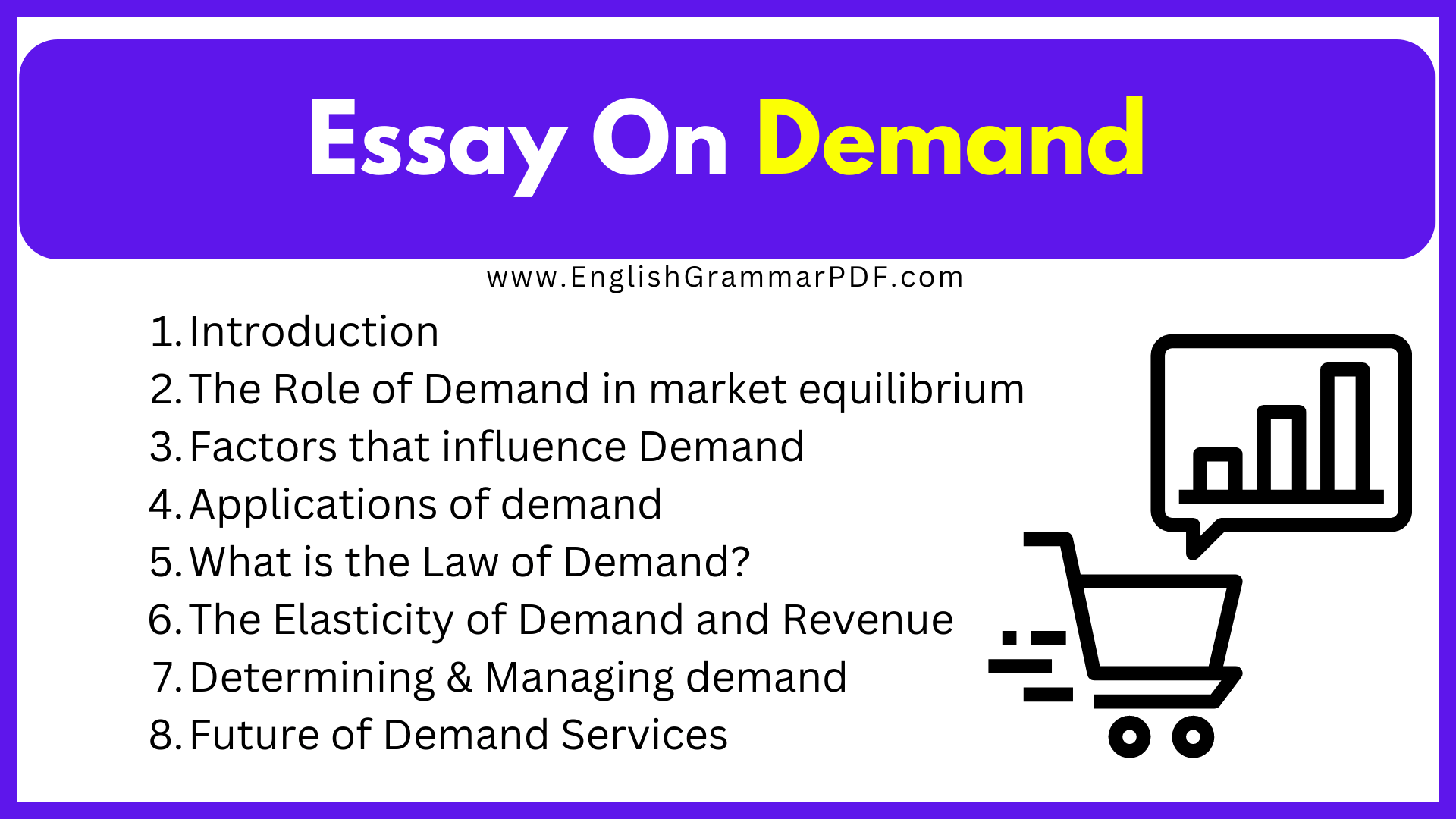
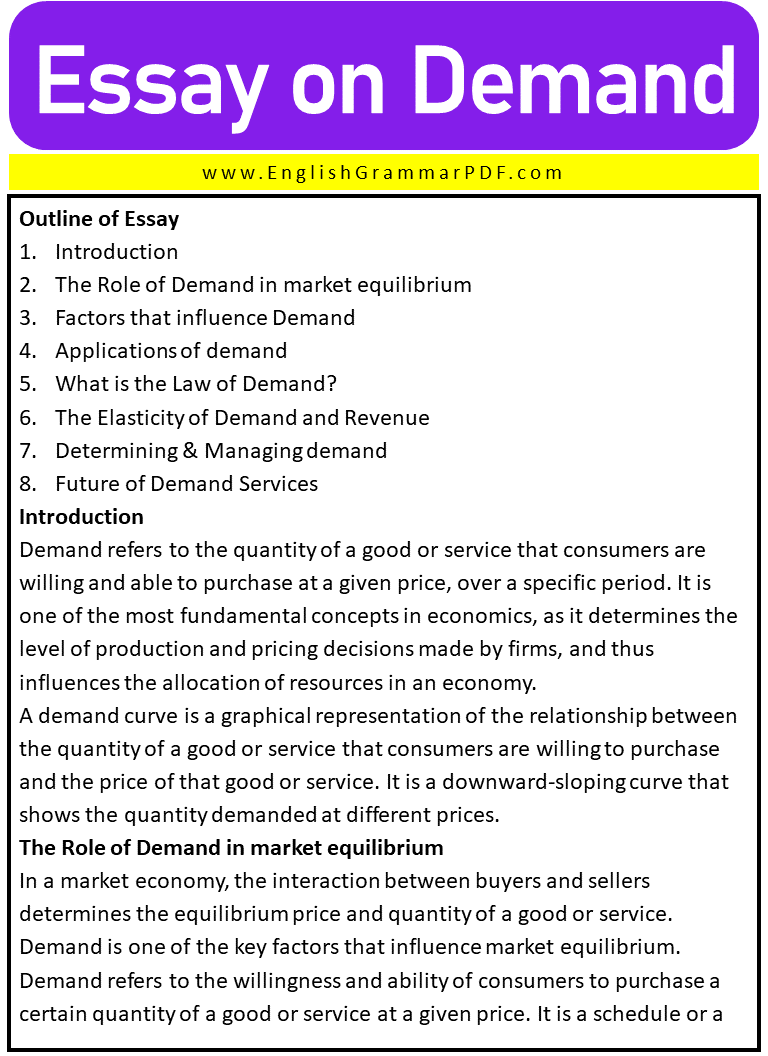
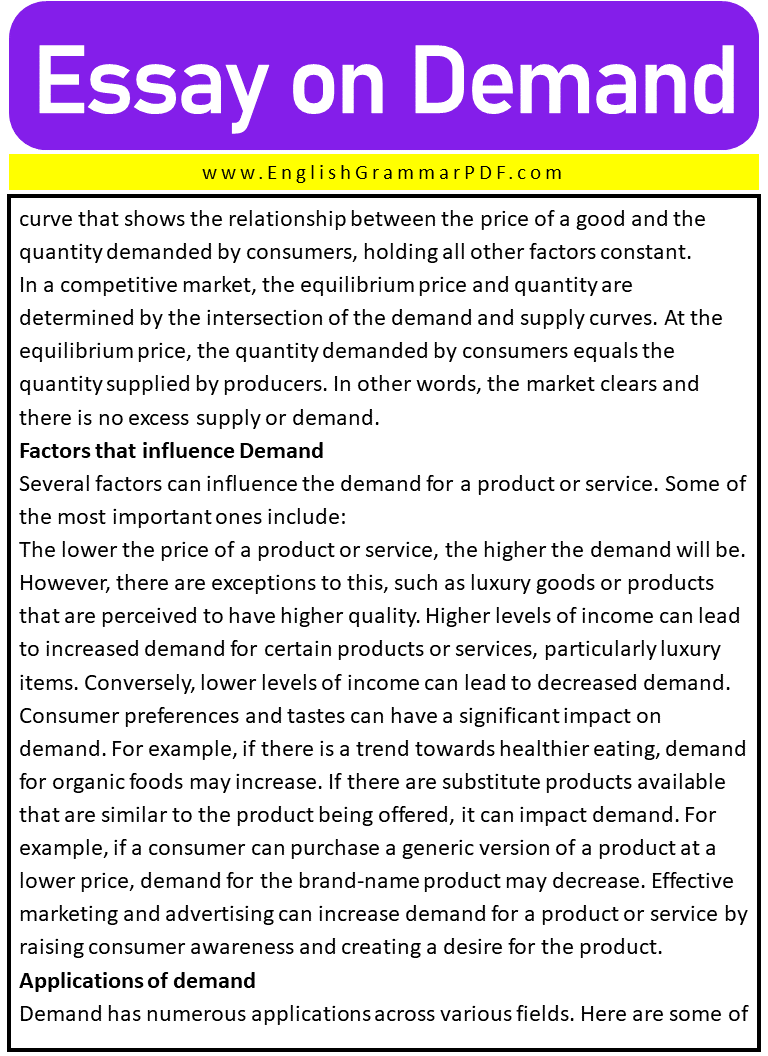
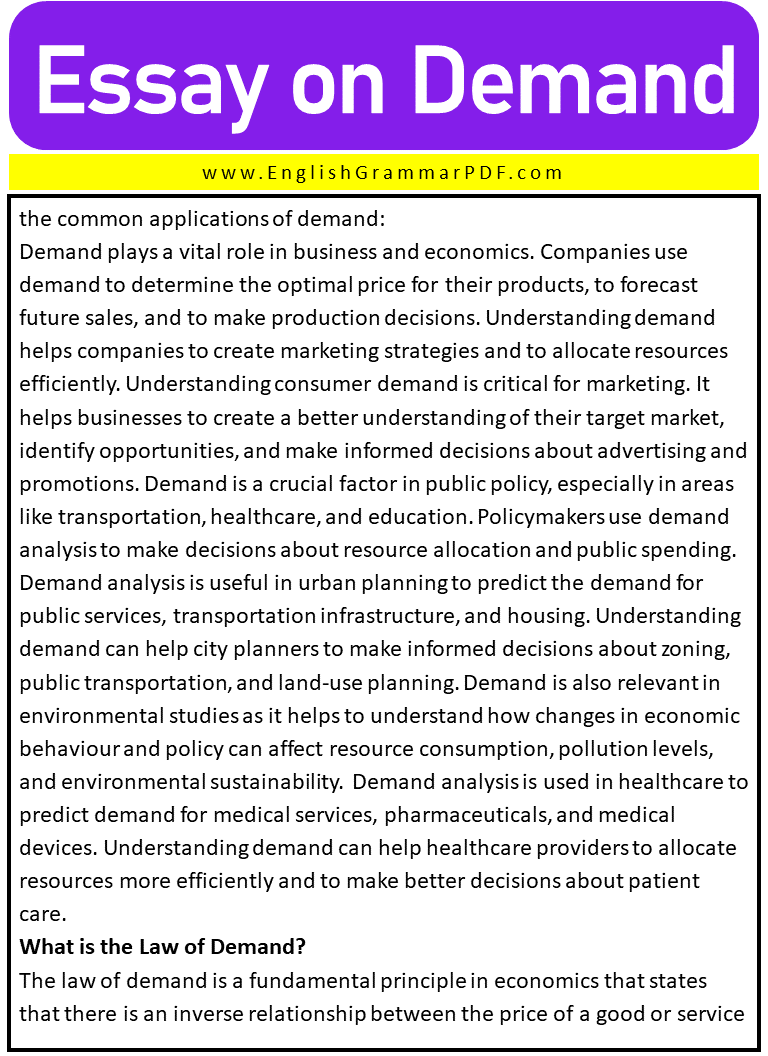
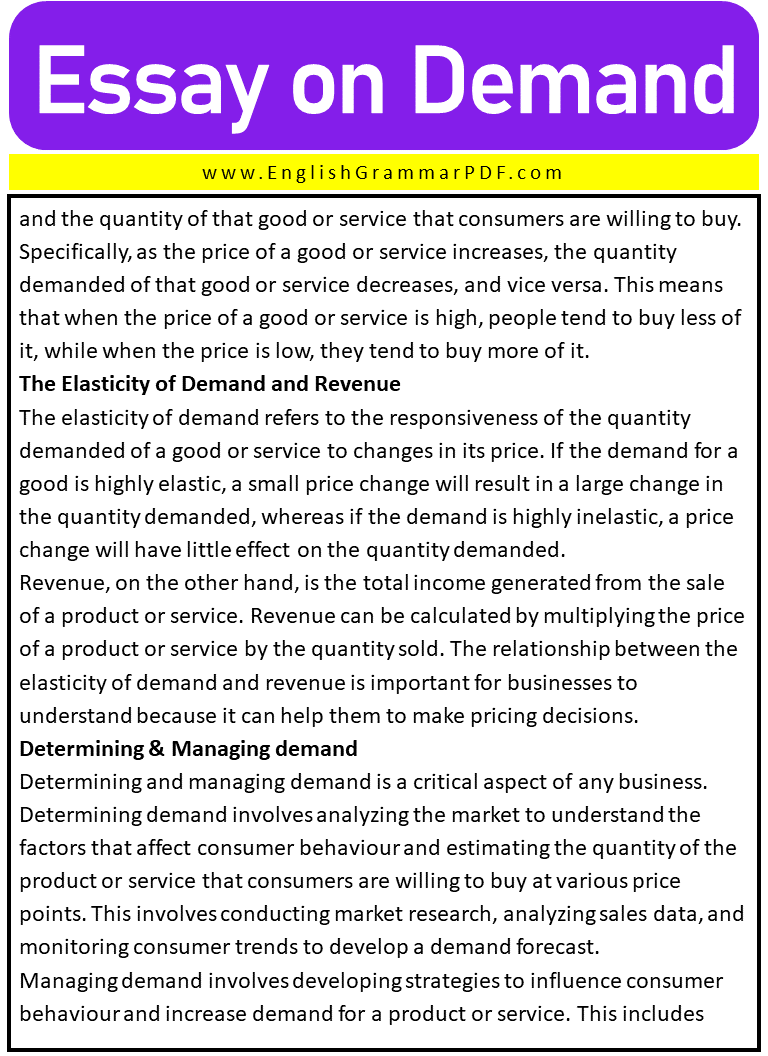
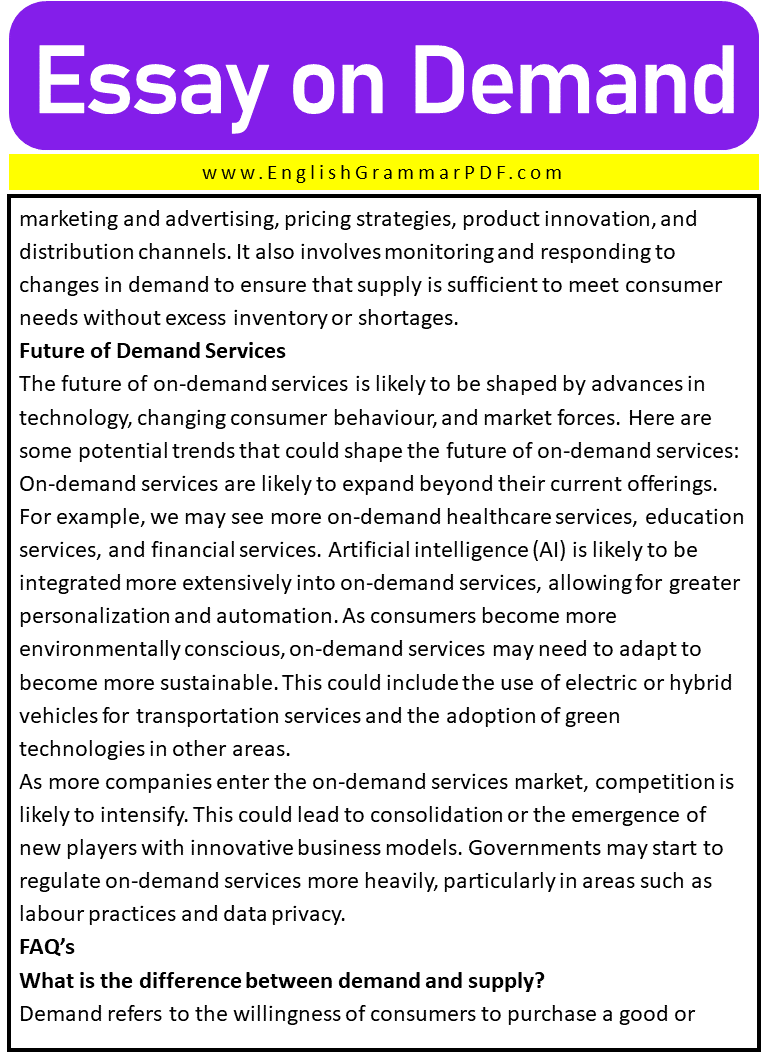
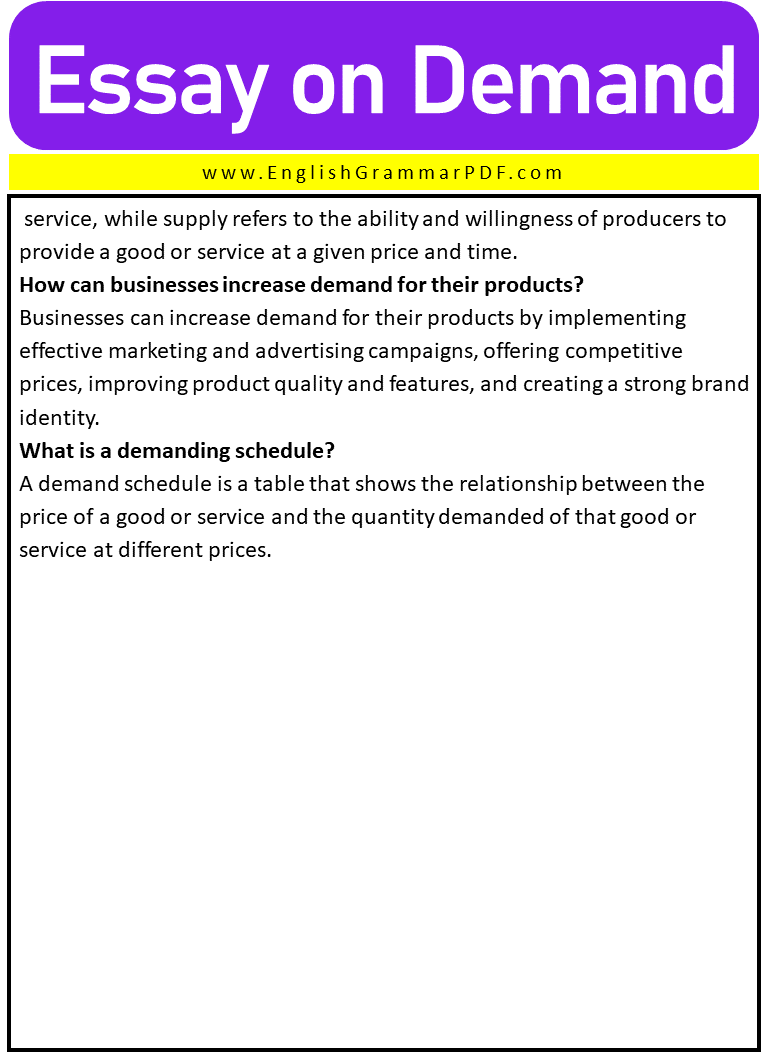
More Essays:


